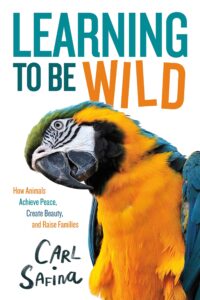Learning to Be Wild: How Animals Achieve Peace, Create Beauty, and Raise Families (A Young Reader’s Adaptation)
Carl Safina
Roaring Brook Press
Published August 22, 2023
Amazon | Bookshop | Goodreads
About Learning to Be Wild
From New York Times -bestselling author Carl Safina comes LEARNING TO BE WILD, a young reader’s adaptation of the notable book BECOMING WILD that explores community, culture, and belonging through the lives of chimpanzees, macaws, and sperm whales.
What do chimpanzees, macaws, and whales all have in common?
Some believe that culture is strictly a human phenomenon. But that’s not true! Culture is passed down from parent to child in all sorts of animal communities. It is the common ground that three very different animals – chimpanzees, macaws, and whales – share.
Discover through the lives of chimpanzees in Uganda, scarlet macaws in Peru, and sperm whales in the Caribbean how they – and we – are all connected in this wonderous journey around the globe.
My Review
I love the idea of adapting a book like this to make it accessible to younger readers. The topic is really intriguing, and I think a lot of readers would find the book engaging.
I thought the writing was a bit dense for a younger audience. There were sections I needed to read more than once to be sure I understood them, so it’s definitely not an easy read. I don’t know how it compares to the adult version. The table of contents shows the same sections, just in a different order, but I’m not sure how much the writing itself was simplified from one version to the other.
The book focuses primarily on three different animal groups: chimpanzees, scarlet macaws, and sperm whales. In each section, the author gives lots of supporting examples of other animals’ behavior and tons of interesting facts scientists have observed about animal culture. I found those snippets and the examples from the main animal groups to be the most interesting parts of the book.
It’s funny that I never really thought about how animals learn things beyond their instinctive behaviors. It makes so much sense that they learn from one another and have their own communities and cultures. I loved getting to peek into what those cultures look like and how they impact animal life.
The book also highlights how decreasing populations due to the destruction of habitat and climate change impact animals, making it harder for them to survive. I hadn’t thought about some of the ways the author lists. Seeing how decreasing population impacts culture and impacts the animal’s ability to survive also helped show how important their cultures are to them. It’s cool to see and study, but it’s also a deeply important element of their lives.
All in all, I love the topic of this book. I wish the writing were a little simpler because it’s got a lot of really great information to share with young readers and animal lovers.
Content Notes
Recommended for Ages 12 up.
Representation
The book focuses on animal behavior but includes references to some human researchers. Some are white. One is African and another is Peruvian.
Profanity/Crude Language Content
None.
Romance/Sexual Content
References to animals choosing mates.
Spiritual Content
None.
Violent Content
Some brief descriptions of animals displaying territorial aggression. Brief descriptions of how a chimpanzee reacts to getting a limb caught in a trap and how that injures them.
Drug Content
Brief mention of cigarette butts collected by birds who use them in their nests to repel insects.
Note: This post contains affiliate links, which do not cost you anything to use, but which help support this blog. I received a free copy of LEARNING TO BE WILD in exchange for my honest review.
